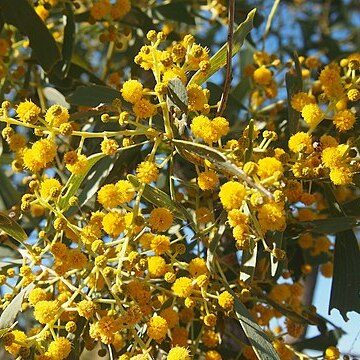Tree or sometimes shrub 3–10 m high. Bark normally rough and ±corky. Branchlets sometimes pendulous, brittle, sometimes pruinose, glabrous. Phyllodes oblanceolate to narrowly oblanceolate, occasionally ±linear, straight to shallowly recurved, 6–15 cm long, usually 10–30 mm wide, normally obtuse, green, yellowish green, grey-green or glaucous, glabrous, with 3 distant main veins and numerous anastamoses forming a close, submerged, net-like reticulum in between. Inflorescences racemose, sometimes in panicles; raceme axes 3–17 cm long, glabrous; peduncles 4–12 mm long, 1-several per node; heads globular, 30–50-flowered, bright golden. Flowers 5-merous; sepals free. Pods narrowly oblong, flat, raised over seed, straight, to 8 cm long, 8–12 mm wide, chartaceous, glabrous. Seeds longitudinal, oblong-elliptic to subcircular, 5.5–6.5 mm long, dull, brown (depressed areole lighter), exarillate.
More
A bushy tree. It grows up to 3-8 m tall. The branches hang downwards. It spreads to 3-4 m wide. The bark is rough and grey. It is a small straggly tree and the young branches are angular. The leaves (phyllodes) are smooth, curved and broadest above the middle. The leaf is 7-10 cm long and 0.8-2.5 cm wide. It is bluish grey. Normally there are 3 clearly seen veins running along the leaf. The leaf normally has a small curved point. The flowers are yellow. They occur in stalked flower branches towards the end of branches. The flowers are balls and 0.5 cm across. The pods are stiff and papery. They are 5-9 cm long by 1-1.5 cm across. The pods are constricted between the seeds. The pods have a wing along the edge. They are light brown when ripe and contain round seeds.


